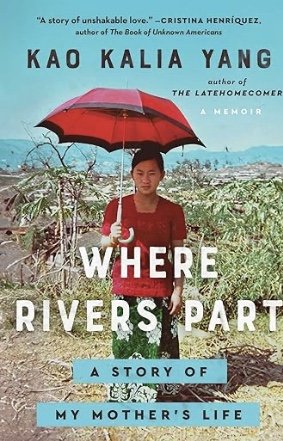Where Rivers Part by Kao Kalia Yang (Simon & Schuster)
Kao Kalia Yang comes from a line of beautiful women who gave birth to equally beautiful daughters. All of them had a special closeness to their mothers and in this lovely history, Yang pays tribute to three generations of these strong and stunning Hmong women.
Beginning with her great-grandmother who was “unexpectedly beautiful…smart and able, though rumored to be promiscuous,” and moving on to the Bad Luck Woman, the grandmother whom Yang never knew except through the stories of her own mother, she then unfolds the story of Tswb, “Chew,” whose own bad luck is counteracted by her quick and determined mind, and who gives birth to daughters whose luck is shaped by the life their mother has made possible.
Chew’s beauty gives her an indulged childhood that ends with the death of her father and the war that takes her away from the village of fruit trees in blossom, where two rivers meet and diverge. In the midst of upheaval and death, Chew’s mother leads her children in a perilous and grueling flight through Laos’ jungles.
This is where Chew first sees the man for whom she will leave her mother. Without hesitation, she marries Npis, “Bee,” a “song poet” whose lack of ambition is counterbalanced by his deep and unflagging love. He pulls her, their infant daughter, and his own mother across the Mekong River into Thailand, and stands on the opposite bank with his skin torn into “pale ribbons of flesh,” shredded by the tubes of bamboo and the ropes that he clutched to bring his family to safety.
But Bee had grown up in poverty. He lacked Chew’s background of comfort and education that drives her to seize all opportunities for a better life. After spending years of squalor in a refugee camp, she persuades him to seek repatriation in another country and two years later, Bee, Chew, and their two children are on a plane that will take them to Minnesota.
In America, they find they “have been tossed through time.” Their daughters swiftly become fluent in English. Chew struggles through two years of night classes to attain a high school diploma while Bee fumes that she’s wasting her time. She “should have just taken the GED test,” as he had. Now he studies at a community college to get a machine operating certificate. They all, parents and daughters, sit at the kitchen table every night, doing their homework.
Chew is constantly pregnant and her children are predominately daughters. She’s determined to break the cycle of “bad luck women” and through her efforts and example, her daughters go to Stanford, Columbia, Carleton College, the University of Minnesota. They live outside of what their mother had known when she “existed in a picture of need.”
Where Rivers Part is the third book in Yang’s trilogy that began with The Latehomecomer (Asia by the Book, April 2008) and The Song Poet (Asia by the Book, March 2021) . Each tells a different segment of Yang’s family history--her own memories of life in the refugee camp with her shaman grandmother and the story of Bee’s life as a child who had never known his father and who struggled to learn how to be a father himself after he and Chew were married. But the most tender and poetic of these three family histories is Yang’s story of her mother.
The story of a girl who grew up in a gentle home, who loved to learn, who fell in love at first sight with a stranger and married him when she was still a child, who gave birth to fourteen children and lost half of them before they left her body, who returned to Laos after her seven surviving children were grown and realized her own mother waited there, ready to welcome her home after she died, is told in words that give Chew’s life the luster of fiction and the blessings of truth.~Janet Brown







